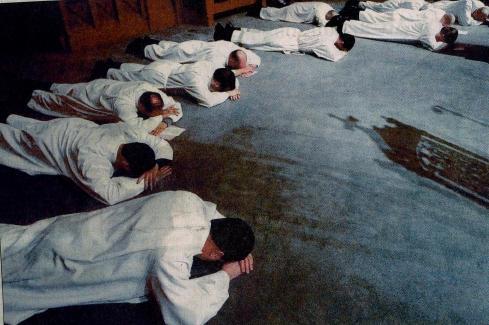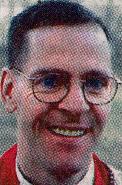Evaluation Intense
Screeners Look for Risk Factors
By Erik Hogstrom
Telegraph Herald [Dubuque IA]
March 8, 2006
http://www.thonline.com/story_news_frontpage.cfm?ID=110931&CFID=
510510&CFTOKEN=b92c10490db68201-D61D2B7D-BCD2-407B-60169BF6AA19F8DE
[See the main page of the Sins & Silence series for links to all the articles and letters to the editor.]
| "I'm not sure you could find a screening process that is
more extensive than this one." Rev. Scott Bullock, director of seminarians for the Archdiocese of Dubuque |
Church officials rely on a battery of screenings to filter out potentially
abusive priests.
"I'm not sure you could find a screening process that is more extensive
than this one," said the Rev. Scott Bullock, director of seminarians
for the Archdiocese of Dubuque.
 |
| Priests and deacons of the Archdiocese of Dubuque participate in a service of atonement at St. Raphael Cathedral in 2003. Prospective priests face several tests before gaining admittance to the seminary. |
Prospective priests face several tests, psychological analyses and questions
about their sexual history—all before gaining admittance to the
seminary.
"That is not to say the process is perfect," Bullock said, "but
it has improved dramatically."
In past generations, a parish priest's recommendation ushered in a relatively
uncomplicated acceptance process into the seminary.
Bullock described the current process as a four- to eight-year period
of "very intense evaluation."
"It requires a man to meet with two psychologists—one is not
sufficient," Bullock said. "We need the experts to tell us."
Those psychologists use a variety of tools to judge a candidate's suitability
to a priest's role, including the celibacy requirements.
"Screening is very helpful because we can identify risk factors,"
said Thomas G. Plante, professor and chairman of the psychology department
at Santa Clara University in California.
The author of "Psychological Patterns Among Roman Catholic Clergy
Accused of Sexual Misconduct," Plante has helped screen prospective
priests for 18 years.
Screeners consider a variety of risk factors that can point toward a possibility
for sexual abuse.
Initially, screeners attempt to identify psychological problems that commonly
occur in conjunction with abuse, including hints of personality disorders,
substance abuse or anxiety disorders.
"Another risk factor is a history of sexual violation themselves,"
Plante said. "A third risk factor is impulse-control problems in
general."
Prospective priests who exhibit problems controlling anger, food intake,
alcohol consumption or gambling present a "red flag."
"A fourth risk factor would be a history of unsuccessful adult relationships—sexual
or not," Plante said.
An inability to forge or maintain healthy adult relationships could signal
a potential for problems.
 |
| Scott Bullock |
"If a man never dated, there is probably a part of that man that
is not fully developed," Bullock said.
Such a situation might not automatically disqualify a seminary candidate,
"But it could call for further evaluation," Bullock said.
Plante said the changing profile of newly ordained priests assists the
screening process.
"In the old days, priests entered religious life at a younger age—often
in their teens," Plante said.
Current seminarians face as many as eight years of religious training
before ordination.
"People are entering the priesthood so much later; the average age
is 29," Plante said. "And a person doesn't wake up at age 40
and decide to become a sex offender."
Instead, that proclivity can begin at a relatively youthful age.
The current age of applicants and length of time before ordination, Plante
said, means "we can screen those who have demonstrated their colors."
"It is so much easier to do that now than generations in the past,"
he said.
Other screenings occur at frequent intervals during a seminarian's career.
"These are the most evaluated men in the nation," Bullock said.
"We are inviting more and more people to comment on this man."
Those who might balk at such scrutiny are reminded of its result.
"We tell them what we are doing is for the good of the church,"
Bullock said.
Plante said current screening methods can greatly reduce the number of
potentially abusive priests.
"You can't bring the number to zero," he said, just as efforts
to root out all potentially abusive Scout leaders and other youth workers
have not been 100 percent successful.
"But we can sure try," he said, "using the best science
we've got."
Publicity surrounding the clergy sex abuse scandal has tightened the screening
process further, Bullock said.
"The priesthood is no place to hide," he said. "Now everybody
knows that."
Any original material on these pages is copyright © BishopAccountability.org 2004. Reproduce freely with attribution.